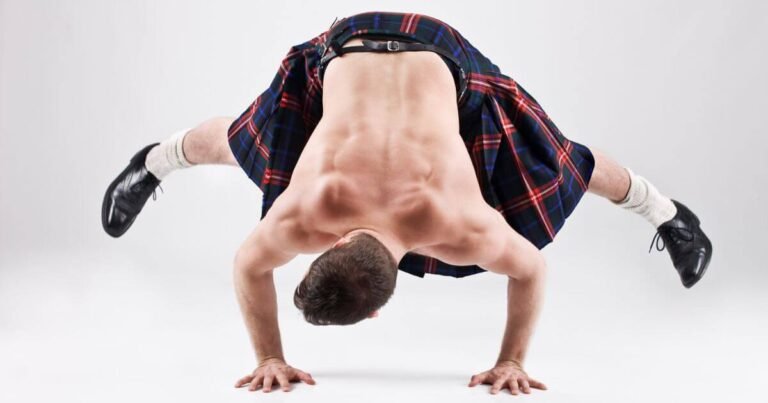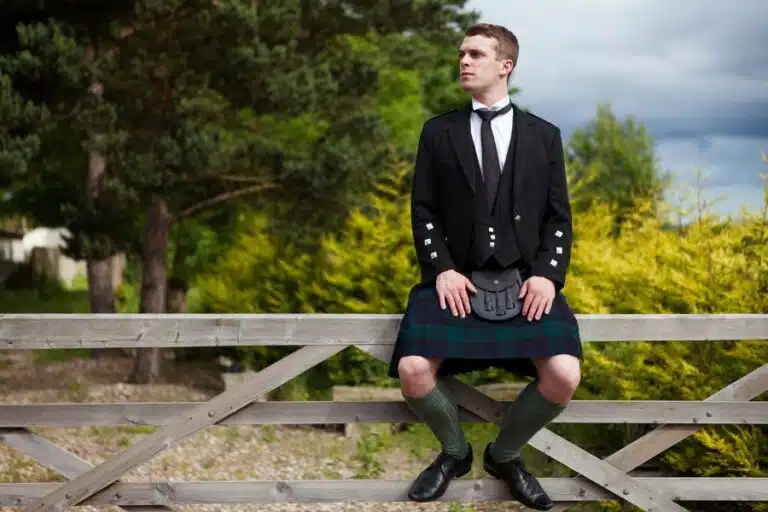What To Wear With a Kilt: Complete Men’s Kilt Outfit Guide
Wearing a kilt feels different. You sense it as soon as you put it on—this weight, the way it moves, how it hangs. It’s not just fabric. It’s tradition, identity, even a bit of defiance if we’re being honest. But once the kilt’s on… what next? What do you actually wear with it?
This is where it gets tricky for a lot of men. You’ve got the kilt—maybe tartan, maybe something more modern—and now you’re standing in front of the mirror thinking: am I doing this right?
Let’s walk through it. Slowly, casually. Like a friend explaining things—not some stiff, overstyled manual.
Start With The Basics: Shirt Choices
This might be the most flexible part of the whole outfit, depending on the occasion. If you’re heading to a formal event (a wedding, say, or a Highland ceremony), you’ll want a crisp dress shirt. White or off-white usually plays it safe. A wing collar or Victorian-style shirt works well with a Prince Charlie jacket, if that’s your thing.
But maybe you’re not going formal. Maybe you’re just going out or attending a casual gathering. Then, honestly? A solid-color button-down or even a plain black T-shirt can work. Yes, even a T-shirt—if you’re confident enough to carry it.
Some guys experiment with denim shirts or short sleeves. Personally, I’ve tried it and felt a little underdressed, but it depends on your style. The key is not to go overly busy up top. Let the kilt be the star.
Jackets: Prince Charlie or Argyle?
If you’re dressing up, your jacket makes a huge difference.
The Prince Charlie jacket is the one most people picture when they think “formal kilt attire.” It’s cropped, sleek, often paired with shiny buttons and a waistcoat (vest). It’s ceremonial. Elegant. Sometimes too elegant, if I’m being honest. But for black-tie events, it’s perfect.
Then there’s the Argyle jacket, which sits a bit lower, has a broader build, and works well for semi-formal or daywear. I like the versatility here—it doesn’t scream for attention, but still feels traditional.
And if you’re going modern? A leather jacket over a mens utility kilt looks kind of rebellious. Or maybe that’s just me projecting a bit.
Sporran: Functional and Decorative
Let’s be real—kilts don’t have pockets. That’s where the sporran comes in.
It’s that pouch hanging in front, and yes, it looks ornamental, but it’s functional too. Keys, phone, cards—it holds your essentials. And, maybe surprisingly, it balances out the look. Try wearing a kilt without one and it feels… incomplete.
There are different types:
- Dress sporrans are more ornate—fur, tassels, sometimes even metal plates.
- Day sporrans are leather, plain, and practical.
- Then there are semi-dress versions that try to land somewhere in between.
I lean toward leather for everyday wear. It doesn’t distract, and it goes with pretty much anything.
Kilt Hose and Flashes: Don’t Skip These
Okay, I know. Socks don’t seem like a big deal. But with a kilt? They’re part of the look.
Kilt hose are those tall, thick socks that reach just below your knees. They’re usually cream, gray, or dark green. You fold the top down to form a cuff—clean, simple.
And peeking out from under that cuff should be flashes—small fabric garters that add color and help hold the hose up. They usually match your kilt or tie. They’re subtle, but kind of important. I skipped them once and felt oddly unfinished.
Footwear: What Works, What Doesn’t
Ghillie brogues are the traditional choice. You’ll know them by the long laces that crisscross up your ankles. They’re a bit of a hassle to tie the first few times, but they look sharp with formal wear.
Still, not every setting calls for brogues. For casual outings, Chelsea boots or even leather combat boots can pair well—especially with utility kilts. I’ve even seen guys wear sneakers with kilts, and while I wouldn’t do it personally, it somehow… works for them?
Just maybe steer clear of flip-flops.
Accessories: When to Go All Out (and When Not To)
Accessories with kilts are like seasoning—just enough adds flavor, too much and it’s overwhelming.
Here are a few options:
- Kilt pin: This one is subtle. It’s not just for show—it helps weigh down the front apron of your kilt to stop it from flapping around. Go simple or engraved. I have one shaped like a sword. Overkill? Maybe.
- Belt and buckle: With a Prince Charlie jacket, skip the belt (the waistcoat covers it anyway). But with a casual or utility kilt? Go for it. Wide leather belts with Celtic buckles look great.
- Sgian-dubh: This is the small knife that tucks into your kilt hose. It’s traditional, symbolic, and in some places, restricted. Know the rules where you are.
A Note on Color Coordination:
Here’s where guys often overthink it.
You don’t need everything to match perfectly. In fact, trying to match your tartan exactly with flashes, tie, and sporran can feel forced. Instead, look for harmony. Let one or two things pop—a tie that picks up a subtle color from your tartan, or flashes that contrast just slightly.
If your kilt is bold, keep the top muted. If your kilt is plain or dark, you’ve got more room to play up top. There are no hard rules here. Just instincts—and the mirror test.
Final Thoughts: Confidence Makes The Outfit
Here’s the part that matters more than any jacket or sporran: how you wear it.
You could have every piece perfectly matched and still feel awkward. Or you could wear a basic kilt and tee combo and turn heads—because you owned it.
Kilts aren’t just garments. They carry weight, both literal and cultural. And the way they’re worn tells a story—sometimes formal, sometimes bold, sometimes quietly proud.
So if you’re putting together your kilt for men outfit and feeling unsure, that’s okay. Try a few combinations. Wear it around the house first. See what feels right. You don’t need to follow every tradition to the letter—just enough to respect it.
The rest? That’s you.













